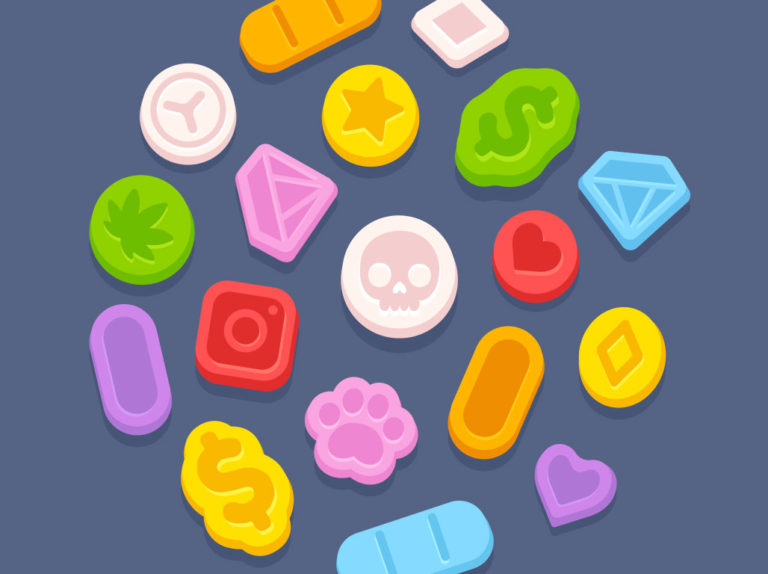LSD is a highly potent synthetic hallucinogen. It is manufactured from a lysergic acid compound found in ergot, a fungus that grows on grains. Because of its high potential for abuse, LSD is currently a Schedule I drug under the Controlled Substances Act of 1970. Currently, there is no accepted medical use in the United States.
LSD History
Swiss chemist Albert Hofmann first synthesized LSD in 1938 as an employee of the Santoz Laboratories. Hofmann was conducting research on the therapeutic value of the lysergic acid compounds as a circulatory and respiratory stimulant, though no great effects were discovered and his research was discontinued. Hofmann discovered the hallucinogenic effects of LSD in 1943 when he accidentally ingested some of the drug. This discovery renewed interest in the drug as a possible treatment for schizophrenia and as a research tool in studying mental illness. In 1947, Sandoz marketed LSD under the trade name “Delsid” as a psychiatric panacea, curing everything from schizophrenia and criminal behavior to sexual perversions and alcoholism; they introduced it to the United States prescription drug market a year later.
From the 1940’s to the mid 1970’s, LSD was extensively researched in the psychiatric community. Psychiatric students were encouraged to use LSD as a teaching tool to help understand schizophrenia. Soon, LSD emerged as a drug of abuse by some in the psychiatric and medical community who shared it with friends. By the 1960’s, casual use of LSD evolved into a subculture that celebrated mysticism and psychedelia and embraced media personalities such as Harvard University instructor Dr. Timothy Leary.
Though casual LSD use spread through the early 1970’s, publicity about the negative effects of LSD, such as “flashbacks” and “bad trips,” as well as prohibitive legislation and the efforts of law enforcement agencies led to a decreased popularity by the mid-seventies. By the early 1980’s, the value of LSD use in psychotherapy was discredited, and scientific study of the drug ended.
Today’s recreational users of LSD often include people in their late teens and early twenties who hear that LSD will “expand their mind” or give them a carefree, euphoric feeling.
Terminology
Acid, Blotter, Cheer, Dots, Hit, Mellow Yellow, L, Lucy, Tabs, Window Pane, Yellow Sunshine, Blue Heaven, Microdot, Cubes
Method of Use
LSD is sold on the street in tablets, capsules and occasionally in liquid form. It is a clear or white odorless substance with a slightly bitter taste. LSD is often added to absorbent paper, such as “blotter” paper — paper that is divided into small decorated squares (or “tabs”), with each square representing one dose called a “hit.” The squares may be colored or have images printed on them. Liquid LSD is clear, and is usually sold in a small container, tube or flask. LSD can also be found in thin squares of gelatin.
Risks Associated with LSD
The effects of LSD are unpredictable and occur based on factors such as on the amount taken, a person’s personality, mood, expectations and the surroundings in which the drug is used. The ability to make sound judgments and see common dangers is impaired, leading to a risk of injury.
In some people, LSD can cause flashbacks, recurrence of certain drug experiences even if the user doesn’t take the drug again. In some people, flashbacks can persist and affect daily functioning, a condition known as hallucinogen persisting perceptual disorder (HPPD).
Tolerance and Withdrawal
LSD does produce tolerance, so some people who take the drug repeatedly must take higher doses to achieve the same effect. This is an extremely dangerous practice, given the unpredictability of the drug. In addition, LSD produces tolerance to other hallucinogens, including psilocybin.
Effects
- Dilated pupils
- Higher body temperature
- Increased heart rate and blood pressure
- Excessive Sweating
- Loss of appetite
- Nausea
- Sleep problems
- Dry mouth
- Tremors
- Uncoordinated movements
- Panic
- Paranoia
- Psychosis
SOURCE: NATIONAL INSTITUTE ON DRUG ABUSE (NIDA);
If you or someone you know needs treatment for substance use, visit Recovery Guidance, the free and safe resource to find addiction and mental health professionals near you.
Save





















